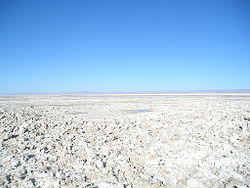



The Puna de Atacama or Atacama Plateau [1] is an arid high plateau, in the Andes of northern Chile (15%) and northwest of Argentina (85%). [2] Geomorphologist Walther Penck based his Grossfalt landform association on Puna de Atacama. [3]




The Puna de Atacama or Atacama Plateau [1] is an arid high plateau, in the Andes of northern Chile (15%) and northwest of Argentina (85%). [2] Geomorphologist Walther Penck based his Grossfalt landform association on Puna de Atacama. [3]
The plateau's elevation averages 4,500 m (14,800 ft) above sea level, and it spans an area of 180,000 km2 (69,000 sq mi).
In Argentina, Puna's territory is extended in the provinces of Salta, Jujuy, and western Catamarca. In Chile, it is included in the regions of Antofagasta and north-eastern Atacama. [2]
In December 2023, scientists, for the first time, reported a recently discovered area on the current planet Earth, particularly in the Puna's territory, which may be similar to ancient Earth, and the related environment of the first life forms on Earth - as well as - similar to possibly hospitable conditions on the planet Mars during earlier Martian times. [4]
Before the War of the Pacific (1879–1883), the region belonged to Bolivia. In 1898, it was ceded to Argentina in exchange for recognition of Tarija as part of Bolivia. Chile, which had annexed the Litoral Province from Bolivia, declared the exchange illegal. The border was defined in 1899 after the Puna de Atacama dispute. Of the 75,000 km2 in dispute, 64,000 (85%) were awarded to Argentina and 11,000 (15%) to Chile. [2]
23°27′36″S67°21′36″W / 23.46000°S 67.36000°W